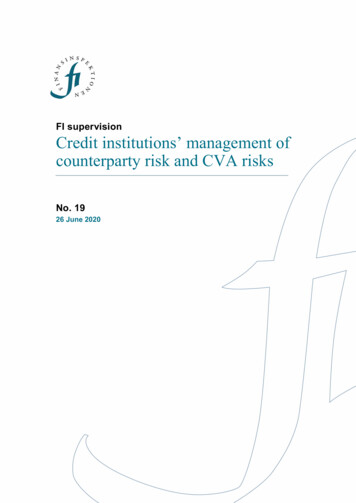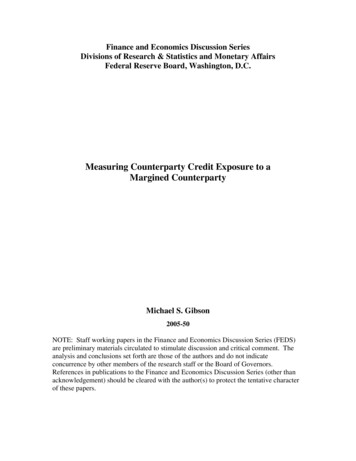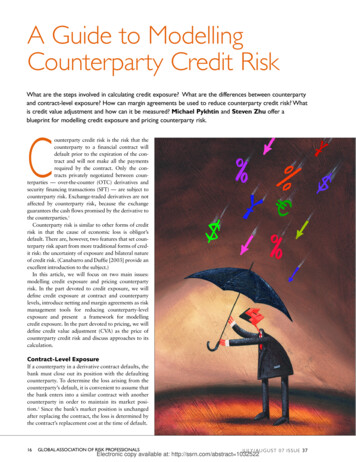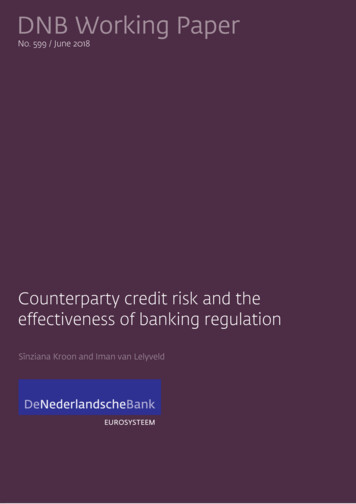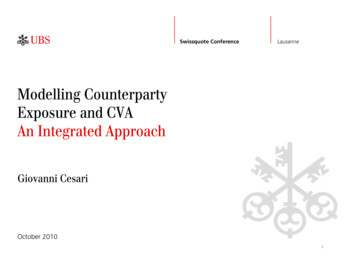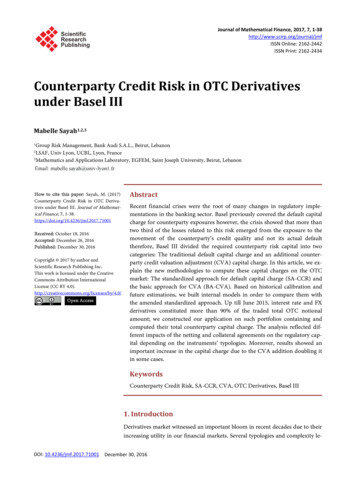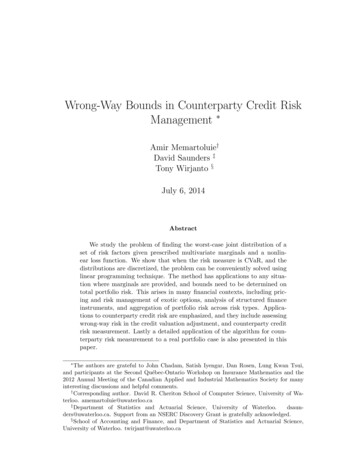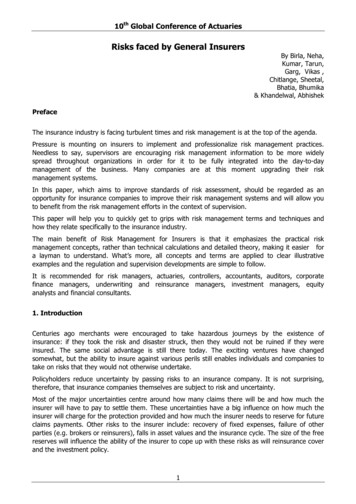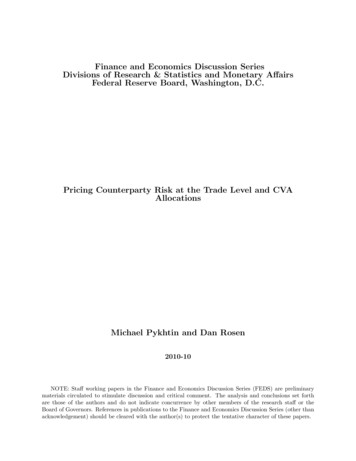
Transcription
Finance and Economics Discussion SeriesDivisions of Research & Statistics and Monetary AffairsFederal Reserve Board, Washington, D.C.Pricing Counterparty Risk at the Trade Level and CVAAllocationsMichael Pykhtin and Dan Rosen2010-10NOTE: Staff working papers in the Finance and Economics Discussion Series (FEDS) are preliminarymaterials circulated to stimulate discussion and critical comment. The analysis and conclusions set forthare those of the authors and do not indicate concurrence by other members of the research staff or theBoard of Governors. References in publications to the Finance and Economics Discussion Series (other thanacknowledgement) should be cleared with the author(s) to protect the tentative character of these papers.
Pricing Counterparty Risk at the Trade Level and CVA Allocations1Michael Pykhtin2 and Dan Rosen3November 2009AbstractWe address the problem of allocating the counterparty-level credit valuationadjustment (CVA) to the individual trades composing the portfolio. We show thatthis problem can be reduced to calculating contributions of the trades to thecounterparty-level expected exposure (EE) conditional on the counterparty’sdefault. We propose a methodology for calculating conditional EE contributionsfor both collateralized and non-collateralized counterparties. Calculation of EEcontributions can be easily incorporated into exposure simulation processes thatalready exist in a financial institution. We also derive closed-form expressions forEE contributions under the assumption that trade values are normally distributed.Analytical results are obtained for the case when the trade values and thecounterparty’s credit quality are independent as well as when there is adependence between them (wrong-way risk).1The opinions expressed here are those of the authors and do not necessarily reflect the views or policies of theiremployers.2Federal Reserve Board, Washington, DC, USA. michael.v.pykhtin@frb.gov.3R2 Financial Technologies and The Fields Institute for Research in Mathematical Sciences, Toronto, Canada.dan.rosen@R2-financial.com and drosen@fields.utoronto.ca1
1. IntroductionFor years, the standard practice in the industry was to mark derivatives portfolios tomarket without taking the counterparty credit quality into account. In this case, all cash flows arediscounted using the LIBOR curve, and the resulting values are often referred to as risk-freevalues.4 However, the true value of the portfolio must incorporate the possibility of losses due tocounterparty default. The credit valuation adjustment (CVA) is, by definition, the differencebetween the risk-free portfolio value and the true portfolio value that takes into account thecounterparty’s default. In other words, CVA is the market value of counterparty credit risk.5There are two approaches to measuring CVA: unilateral and bilateral (see Picoult, 2005or Gregory, 2009). Under the unilateral approach, it is assumed that the counterparty that doesthe CVA analysis (we call this counterparty a bank throughout the paper) is default-free. CVAmeasured this way is the current market value of future losses due to the counterparty’s potentialdefault. The problem with unilateral CVA is that both the bank and the counterparty require apremium for the credit risk they are bearing and can never agree on the fair value of the trades inthe portfolio. Bilateral CVA takes into account the possibility of both the counterparty and thebank defaulting. It is thus symmetric between the bank and the counterparty, and results in anobjective fair value calculation.Under both, the unilateral and bilateral approaches, CVA is measured at the counterpartylevel. However, it is sometimes desirable to determine contributions of individual trades to thecounterparty-level CVA. The problem of calculating CVA contributions bears many similaritiesto the calculation of risk contributions and capital allocation (see Aziz and Rosen 2004, Mausserand Rosen 2007). There are several possible measures of CVA contributions. We refer to theCVA of each transaction on a stand-alone basis as the transaction’s stand-alone CVA. Clearly,when the given portfolio does not allow for netting between trades, the portfolio-level CVA isgiven by the sum of the individual trades’ stand-alone CVA. However, this is not the case whennetting and margin agreements are in place. We refer to the incremental CVA contribution of atrade as the difference between the portfolio CVA with and without the trade.6 This measure iscommonly seen as appropriate for pricing counterparty risk for new trades with the counterparty(see Chapter 6 in Arvanitis and Gregory, 2001 for details). One problem with incremental CVAcontributions is that they are non-additive – the sum of the individual trade’s CVA contributionsdoes not add up to the portfolio’s CVA. Hence neither stand-alone nor incremental contributionscan be used effective contributions of existing trades in the portfolio to the counterparty-levelCVA, in the presence of netting and/or margin agreements. For this purpose we require additiveCVA contributions. In this case, we draw the analogy with the capital allocation literature andrefer to these as (continuous) marginal risk contributions.4More precisely, LIBOR rates roughly correspond to AA risk rating and incorporate the typical credit risk of largebanks.5See Canabarro and Duffie (2003) or Pykhtin and Zhu (2007) for an introduction to counterparty credit risk andCVA.6Sometimes these are referred to as discrete marginal contributions.2
The marginal CVA contributions with a given counterparty give the bank a clear picturehow much each trade contributes to the counterparty-level CVA. However, the use of CVAcontributions is not limited to an analysis at a single counterparty level. Once the CVAcontributions have been calculated for each counterparty, the bank can calculate the price ofcounterparty credit risk in any collection of trades without any reference to the counterparties.For example, by selecting all trades booked by a certain business unit or product type (e.g., allCDSs or all USD interest rate swaps), the bank can determine the contribution of that businessunit or product to the bank’s total CVA.We show how to define and calculate marginal CVA contributions in the presence ofnetting and margin agreements, and under a wide range of assumptions, including thedependence of exposure on the counterparty’s credit quality. The theory of marginal riskcontributions, sometimes refer to as Euler Allocations (see Tasche 2008), is now well developedand largely relies on the risk function being homogeneous (of degree one). We show that thisprinciple can be applied readily for CVA when the counterparty portfolio allows for netting (butdoes not include collateral and margins). We further extend this allocation principle for the moregeneral case of collateralized/margined counterparties For the sake of simplicity, we assume theunilateral framework throughout the paper. However, an extension of all the results to thebilateral framework is straightforward.The paper is organized as follows. In Section 2, we define counterparty credit exposurefor both collateralized and non-collateralized cases. We show how counterparty-level CVA canbe calculated from the profile of the discounted risk neutral expected exposure (EE) conditionalon the counterparty’s default. In Section 3, we introduce CVA contributions of individual tradesand relate them to the profiles of conditional EE contributions. In Section 4, we adapt thecontinuous marginal contribution (CMC) method often used for allocating economic capital tocalculating EE contributions for the case when the counterparty-level exposure is a homogeneousfunction of the trades’ weights in the portfolio. This is the case when there are no exposurelimiting agreements, such as margin agreements, with the counterparty. When such agreementsare present, the CMC method fails because the counterparty-level exposure is not homogeneousanymore. In Section 5, we propose an EE allocation scheme that is based on the CMC method,but can be used for collateralized counterparties. In Section 6, we show how to incorporate EEand CVA contribution calculations into exposure simulation process. In Section 7, we deriveclosed form expressions for EE contributions under the assumption that all trade values arenormally distributed. We start with the case of independence between exposure and thecounterparty’s credit quality, and extend the results to incorporate dependence between them(wrong-way risk). We also provide an intuitive explanation to our closed-form results. In Section8, we show several numerical examples that illustrate the behavior of exposure (and hence CVA)contributions for both, the collateralized and non-collateralized cases.3
2. Counterparty credit risk and CVAIn this section, we review the basic concepts and notation for counterparty credit risk,credit exposures and CVA.Counterparty credit risk (CCR) is the risk that the counterparty defaults before the finalsettlement of a transaction's cash flows. An economic loss occurs if the counterparty portfoliohas a positive economic value for the bank at the time of default. Unlike a loan, where only thelending bank faces the risk of loss, CCR creates a bilateral risk: the market value can be positiveor negative to either counterparty and can vary over time with the underlying market factors. Wedefine the counterparty exposure E (t ) of the bank to a counterparty at time t as the economicloss, incurred on all outstanding transactions with the counterparty if the counterparty defaults att , accounting for netting and collateral but unadjusted by possible recoveries.2.1 Counterparty exposuresConsider a portfolio of N derivative contracts of a bank with a given counterparty. Thematurity of the longest contract in the portfolio is T . The counterparty defaults at a random timeτ with a known risk-neutral distribution P(t ) Pr[τ t ] .7 We further assume that thedistribution of the trade values at all future dates is risk neutral.8Denote the value of the ith instrument in the portfolio at time t from the bank’sperspective by Vi (t ) . At each time t, the counterparty-level exposure E (t ) is determined by thevalues of all trades with the counterparty at time t, {Vi (t )}iN 1 . The value of the counterpartyportfolio at t is given byNV (t ) Vi (t )(1)i 1When netting is not allowed, the (gross) counterparty-level exposure E (t ) isNE ( t ) max {0,Vi (t )}(2)i 1For a counterparty portfolio with a single netting agreement, the (netted) exposure isE (t ) max {V (t ), 0}7(3)The term structure of risk neutral probabilities of default can be obtained from credit default swaps spreads quotedfor the counterparty on the market for different of different maturities. See, for example, Schönbucher (2003).8See, for example, Brigo and Masetti (2005).4
When the netting agreement is further supported by a margin agreement, the counterpartymust provide the bank with collateral whenever the portfolio value exceeds a threshold. As theportfolio value drops below the threshold, the bank returns collateral to the counterparty.Collateral transfer occurs only when the collateral amount that needs to be transferred exceeds aminimum transfer amount. The counterparty-level (margined) exposure is given byE (t ) max {V (t ) C (t ), 0}(4)where C (t ) is the collateral available to the bank at time t.Counterparty portfolios with a combination of multiple netting agreements and tradesoutside of these agreements can be modeled in a straightforward way by a combination ofEquations (2)-(4).2.2 Models of CollateralWe start modeling collateral with a simplifying assumption: we incorporate the minimumtransfer amount into the threshold H and treat the margin agreement as having no minimumtransfer amount. This approximation is rather crude, but it is very popular amongst banksbecause it greatly simplifies modeling.We consider two models of collateral. In the instantaneous collateral model, we assumethat collateral is delivered immediately and that the trades can be liquidated immediately as well.Under these simplifying assumptions, the collateral available to the bank isC (t ) max {V (t ) H ,0}(5)The instantaneous collateral model is attractive because of its simplicity, but is rarely used inpractice because its assumptions materially affect the exposure distribution.9 However, we usethis model to show the simple, intuitive interpretation of our results for collateralized netting.A more realistic collateral model must account for the time lag between the last margincall made before default and the settling of the trades with the defaulting counterparty. This timelag, which we denote by δ t , is known as the margin period of risk. While the margin period ofrisk is not known with certainty, we follow the standard practice and assume that it is adeterministic quantity that is defined at the margin agreement level.10 We assume that thecollateral available to the bank at time t is determined by the portfolio value at time t δ taccording toC (t ) max {V (t δ t ) H ,0}9(6)When the threshold is not too small, the instantaneous collateral model works reasonably well for expectedexposure. See Pykhtin (2009).5
We refer to this more realistic model as the lagged collateral model. While more difficult toimplement, it is often used by banks to obtain results, which have more practical value.2.3 Credit losses and CVAIn the event that the counterparty defaults at time τ , the bank recovers a fraction R of theexposure E (τ ) . The bank’s discounted loss due to the counterparty’s default isL 1 τ T (1 R) E (τ ) D(τ ){ }(7)where 1{ A} is the indicator function that takes value 1 when logical variable A is true and value 0otherwise, D(t ) is the stochastic discount factor process at time t, defined according toD (t ) B0 Bt , with Bt the value of the money market account at time t.The unilateral counterparty-level CVA is obtained by applying the expectation toEquation (7). This results inTCVA (1 R) dP(t ) eˆ (t )(8)0where eˆ (t ) is the risk-neutral discounted expected exposure (EE) at time t, conditional on thecounterparty’s default at time t:eˆ (t ) Eˆ t [ D(t ) E (t )] E D(t ) E (t ) τ t (9)Throughout this paper we use “star” to designate discounting and “hat” to designate conditioningon default at time t. Note that we have not made so far any assumptions on whether the exposuredepends on the counterparty’s credit quality.3. CVA Contributions from EE ContributionsWe would like to develop a general approach to calculating additive contributions ofindividual trades to the counterparty-level CVA. We denote the contribution of trade i by CVA i .We say that CVA contributions are additive when they sum up to the counterparty-level CVA:NCVA CVA i(10)i 110The margin period of risk depends on the contractual margin call frequency and the liquidity of the portfolio. Forexample, δ t 2 weeks is usually assumed for portfolios of liquid contracts and daily margin call frequency.6
Note that the recovery rate R and the default probabilities P (t ) are defined at the counterpartylevel in Equation (8). Thus, the problem of calculating CVA contributions reduces to that ofcalculating contributions of individual trades to the portfolio conditional discounted EE, eˆi (t ) , ateach future date. To obtain additive CVA contributions, then the conditional discounted EEcontributions must sum up to the portfolio conditional discounted EE:Neˆ (t ) eˆi (t )(11)i 1and the CVA contribution of trade i can be calculated from its EE contribution according toTCVAi (1 R ) dP(t ) eˆi (t )(12)0Thus, from now on we focus on defining and calculating EE contributions.Note first that, without netting agreements, the allocation of the counterparty-level EEacross the trades is trivial because the counterparty-level exposure is the sum of the stand-aloneexposures (Equation (2)) and expectation is a linear operator. Furthermore, when there is morethan one netting set with the counterparty (e.g., multiple netting agreements, non-nettabletrades), we can focus on first calculating the CVA contribution of a transaction to its netting set.The allocation of the counterparty-level EE across the netting sets is then trivial again becausethe counterparty-level exposure is defined as the sum of the netting-set-level exposures. Thus,our goal is to allocate the netting-set-level exposure to the trades belonging to that netting set. Tokeep the notation simple, we assume from now on that all trades with the counterparty arecovered by a single netting set.4. Additive EE Contributions for Non-collateralized Netting SetsIn this section, we develop the basic methodology to compute EE contributions andallocate portfolio-level EE for non-collateralized netting sets.4.1 Continuous Marginal Contributions and Euler AllocationWe derive EE contributions by adapting the continuous marginal contributions (CMC)method from the economic capital (EC) literature. EC is calculated at the portfolio level and thenit is allocated to individual obligors and transactions. Under the CMC method, the riskcontribution of a given transaction to the portfolio EC is determined by the infinitesimalincrement of the EC corresponding to the infinitesimal increase of the transaction’s weight in theportfolio (see Chapter 4 in Arvanitis and Gregory (2001) or Tasche (2008) for details). Thisfollows from the fact that the risk function is homogeneous (of degree one) and the application ofEuler’s theorem.7
A real function f (x) of a vector x ( x1 , . , xN ) is said to be homogeneous of degree βif for all c 0 , f (c x ) c β f ( x ) . If the function f ( ) is piecewise differentiable, then Euler’stheorem states that:Nβ f ( x) i 1 f (x) xi xi(13)The risk measures most commonly used, such as standard deviation, value-at-risk (VaR) andexpected shortfall, are homogeneous functions of degree one ( β 1 ) in the portfolio positions.Thus, Euler’s theorem is applied to allocate EC and compute risk contributions across portfolios.If x denotes the vector of positions in a portfolio, and EC(x) the correspondingeconomic capital, then Euler’s theorem implies additive capital contributionsNEC(x) ECi (x)(14)i 1where the termsECi (x) EC(x) xi xi(15)are referred to as the marginal capital contributions of the portfolio.4.2 Continuous Marginal EE Contributions for netted exposures without collateralConsider now the calculation of EE contributions. Assume that we can adjust the size ofany trade in the portfolio by any amount. Define the weight α i for trade i as a scale factor thatrepresents the relative size of the trade in the portfolio, Vi (α i , t ) α iVi (t ) . These weights canassume any real value, with α i 1 corresponding to the actual size of the trade and α i 0 beingthe complete removal of the trade. We describe adjusted portfolios via the vector of weightsα (α1 ,K,α N ) . For adjusted portfolios, we use the notations E (α, t ) , eˆ (α , t ) , and CVA(α ) forthe exposure and EE at time t and CVA. Furthermore, for convenience, denote by 1 (1,K,1)the vector representing the original portfolio.When there is no margin agreement between the bank and the counterparty, thecounterparty-level exposure is a homogeneous function of degree one in the trade weights:E (cα, t ) cE (α, t )8(16)
The intuition behind Equation (16) is simple: if the bank uniformly doubles the size of itsportfolio with the counterparty by entering into exactly the same trade with the counterparty foreach existing trade, the bank’s exposure doubles.We define the continuous marginal EE contribution of trade i at time t as the infinitesimalincrement of the conditional discounted EE of the actual portfolio at time t resulting from aninfinitesimal increase of trade i’s presence in the portfolio, scaled to the full trade amount: eˆi (t ) limδ 0eˆ (t , 1 δ ui ) eˆ (t )δ eˆ (t , α ) α i α 1(17)where ui describes a portfolio whose only component is one unit of trade i. Since the portfolioexposure is homogeneous in the trades’ weights, the EE contributions defined by Equation (17)automatically sum up to the counterparty-level conditional discounted EE by Euler’s theorem(Equation (13)).We can derive an expression for the marginal EE contributions as follows. First,substitute Equation (9) into Equation (17) and bring the derivative inside the expectation. Thisresults in E (α, t )eˆi (t ) Eˆ t D(t ) α i α 1 (18)where exposure of the adjusted portfolio (with weight vector α (α1 ,K,α N ) ) is given by N E (α, t ) max α iVi (t ), 0 i 1 (19)Calculating the first derivative of the exposure with respect to the weight α i and setting allweights to one, we have: E (α, t ) V (α, t ) Vi (t ) 11{V (α,t ) 0}max {V (α, t ), 0}{V (t ) 0}α α i α 1 α i iα 1α 1(20)Substituting Equation (20) into Equation (18), we obtain the EE contribution of trade i: eˆi (t ) Eˆ t D(t )Vi (t ) 1{V (t ) 0} (21)The EE contribution of trade i is the expectation of a function which considers the discountedvalues of the trade on all scenarios where the total counterparty exposure is positive, or zerootherwise. As expected, the EE contributions sum up to the counterparty-level discounted EE:9
N eˆ (t ) Eˆii 1t D (t )V (t ) 1 Eˆ D (t ) max {V (t ),0} eˆ (t )t {V (t ) 0} 5. Additive EE Contributions for Collateralized Netting SetsConsider now a counterparty that has a single netting agreement supported by a marginagreement, which covers all the trades with the counterparty. As discussed in Section 2, thecounterparty-level stochastic exposure is given by Equation (4), where the collateral available tothe bank is given either by the instantaneous collateral model (Equation (5)) or by the laggedcollateral model (Equation (6)). In what follows, we specify additive EE contributions for bothmodels, starting with the simpler instantaneous collateral model.5.1 Instantaneous Collateral ModelSubstituting Equation (5) into Equation (4), we obtainE (t ) V (t )1 0 V (t ) H H 1 V (t ) H{}{}(22)As can be seen from Equation (22), the expected exposure in not a homogeneous function of thetrades’ weights and, hence, the CMC approach cannot be applied directly. From themathematical point of view, the conditions of Euler’s theorem are not satisfied, and the CMCs,as given earlier, do not sum to the counterparty-level discounted EE anymore. To understandconceptually how the CMC method fails, notice that when the portfolio value is above thethreshold, the counterparty-level exposure equals the threshold. An infinitesimal increase of anytrade’s weight in the portfolio is not sufficient to bring the portfolio value below the threshold.Thus, the counterparty-level exposure is not affected by the infinitesimal weight changes, and theexposure contribution is zero for all scenarios with the portfolio value above the threshold.However, we still would like to “allocate” the non-zero collateralized counterparty-levelexposure (equal to the threshold) to the individual trades, so that these allocations cannot be allequal to zero.We can derive additive contributions for this non-homogeneous case, which areconsistent with the continuous marginal contributions as follows. First, notice that, while theexposure function in Equation (22) is not homogeneous in the vector of weights α (α1 ,K,α N ) ,the functionE ( α′, t ) V ( α, t ) 1 0 V{(α ,t ) α H H } α H H 1 V{ (α ,t ) α H H }(23)is a homogeneous function in the extended vector of weights α ' (α1 ,., α N , α H ) . That is, weconsider scaling the each of the trades as well as the threshold H. Thus, we can think of thecontribution of the threshold itself to the counterparty-level exposure.The first derivatives of the exposure with respect to the trade weights is given by10
E (α′, t ) Vi (t ) 1 0 V (t ) H{} α i α ′ 1(24)Similarly, the derivative with respect to the threshold weight is E (α′, t ) H 1 V (t ) H{} α H α ′ 1(25)Note that these sum up to the counterparty-level exposure given by Equation (22), as expected.By applying discounting and taking conditional expectation of the right-hand side of Equations(24) and (25), we obtain the EE contributions of the tradeseˆi , H (t ) Eˆ t D(t ) Vi (t ) 1{0 V (t ) H } (26)eˆH (t ) H Eˆ t D(t ) 1{V (t ) H } (27)and of the thresholdwhich satisfyNeˆ (t ) eˆi , H (t ) eˆH (t )(28)i 1The contribution of the threshold can be interpreted as the change of the conditional discountedEE associated with an infinitesimal shift of the threshold upwards scaled up by the actual size ofthe threshold. Note that, when the threshold goes to infinity, the last term vanishes and werecover the uncollateralized contributions.As the final step, we “allocate back” the contribution adjustment of the collateralthreshold given by Equation (27) to the individual trades, so that Equation (28) can be written interms of EE contributions only of the trades (as in Equation (11)):Neˆ (t ) eˆi (t )i 1There are several possibilities for allocating the amount eˆH (t ) in meaningful proportionsto each trade. Given that that the adjustment of the trade contributions occurs when the portfoliovalue exceeds the threshold, a meaningful weighting scheme is given by the ratio of theindividual instrument’s expected discounted value when the threshold is crossed to the totalcounterparty discounted value when this occurs:11
Ê t D(t ) Vi (t ) 1{V (t ) H } N ˆE D(t ) 1ˆED(t)1 t tV(t) HV(t) H{} {} i 1Êt D(t ) V (t ) 1{V (t ) H } (29)Thus, the individual trade contributions to EE are given byeˆi (t ) Eˆ t D(t )Vi (t ) 1{0 V (t ) H } H Êt D(t ) 1{V (t ) H } Eˆ D(t )V (t ) 1 (30)t iV (t ) H } { Ê t D(t ) V 1{V (t ) H } Both terms of Equation (30) have a straightforward interpretation: the first term is thecontribution of all scenarios where the bank holds no collateral at time t, while the second term isthe contribution of all scenarios where the bank holds non-zero collateral at time t.We refer to the allocation scheme above as type A allocation. An alternative allocationscheme (type B) is obtained by bringing the weighting scheme of the threshold contribution nowinside the expectation operator, so that instead of Equation (29) we now have:N NV (t ) V (t ) 1 ii Eˆ t D (t ) i 1 V (t ) H (31)Eˆ t D (t ) 1{V (t ) H } Eˆ t D(t ) 1{V (t ) H } {} V (t ) i 1 V (t )i 1 NThis leads to the continuous marginal contributions given by V (t )eˆi* (t ) Eˆ t D(t )Vi (t ) 1{0 V (t ) H } H Eˆ t D(t ) i 1{V (t ) H } V (t ) (32)Both terms on the right hand of Equation (32) have the same interpretation as before.5.2 Lagged Collateral ModelWe now apply the formalism developed for the continuous collateral model to the laggedcollateral model. In this case, the counterparty credit exposure is obtained by substitutingEquation (6) into Equation (4):E (t ) V (t ) 1 0 V (t ) H δ V (t ) [ H δ V (t )] 1 0 H δ V (t ) V (t ){}{}(33)where δ V (t ) V (t ) V (t δ t ) is the change of the portfolio value from the look-back time pointt δ t to the time point of interest t . Note that as the margin period of risk, δ t , vanishes, thisexpression reduces to Equation (22), which gives the exposure with instantaneous collateral.12
Indeed, a zero margin period of risk implies a zero change of portfolio value from t δ t to t ,since both time points are the same now.As defined for the instantaneous model, we rewrite the exposure given by Equation (33)as a homogeneous function in the extended vector of weights α ' (α1 ,.,α N , α H ) :E (α′, t ) V (α, t ) 1 0 V ( α ,t ) α{HH δ V (α ,t )} [α H H δ V (α, t )] 1 0 α{HH δ V (α ,t ) V (α ,t )}(34)whereNδ V (α, t ) α iδ Vi (t )(35)i 1and δ Vi (t ) Vi (t ) Vi (t δ t ) . The first derivatives of exposure with respect to the trades’weights and with respect to the threshold weight are given, respectively, by E (α′, t ) Vi (t ) 1 0 V (t ) H δ V (t ) δ Vi (t ) 1 0 H δ V (t ) V (t ){}{} α i α ′ 1(36) E (α′, t ) H 1 0 H δ V (t ) V (t ){} α i α ′ 1(37)The sum these first derivatives across all the trades and the threshold, gives the counterpartylevel exposure, Equation (33). By applying discounting and taking the conditional expectationof the right-hand side of Equations (36) and (37), we obtain the EE contributions of the tradeseˆi , H (t ) Eˆ t D(t ) Vi (t ) 1 0 V (t ) H δ V (t ) Eˆ t D(t ) δ Vi (t ) 1 0 H δ V (t ) V (t ) {} {} (38)and of the thresholdeˆH (t ) H Eˆ t D(t ) 1 0 H δ V (t ) V (t ) {} (39)Now we need to allocate back the threshold contribution, Equation (39), to the individualtrades. Following the type A allocation scheme in the previous section, eˆH (t ) is allocated toindividual trades in proportion to the expectation of the discounted trade values when0 H δ V (t ) V (t ) . This results in the trade allocations given by13
eˆi (t ) Eˆ t D(t ) Vi (t ) 1 0 V (t ) H δ V (t ) Eˆ t D(t ) δ Vi (t ) 1 0 H δ V (t ) V (t ) {} {} Êt D(t ) Vi (t ) 1 0 H δ V (t ) V (t ) {} H Êt D(t ) 1 0 H δ V (t ) V (t ) {} Ê t D(t ) V (t ) 1 0 H δ V (t ) V (t ) {} (40)In the type B allocation, we bring the weighting scheme inside the expectation operator. Thisgiveseˆi (t ) Eˆ t D(t ) Vi (t ) 1 0 V (t ) H δ V (t ) Eˆ t D(t ) δ Vi (t ) 1 0 H δ V (t ) V (t ) {} {} V (t ) H Êt D(t ) i 1 0 H δ V (t ) V (t ) {}V (t ) (41)It is straightforward to verify that the lagged EE contributions degenerate to t
The credit valuation adjustment (CVA) is, by definition, the difference . In other words, CVA is the market value of counterparty credit risk.5 There are two approaches to measuring CVA: unilateral and bilateral (see Picoult, 2005 or Gregory, 2009). Under the unilateral approach, it is assumed that the counterparty that does


